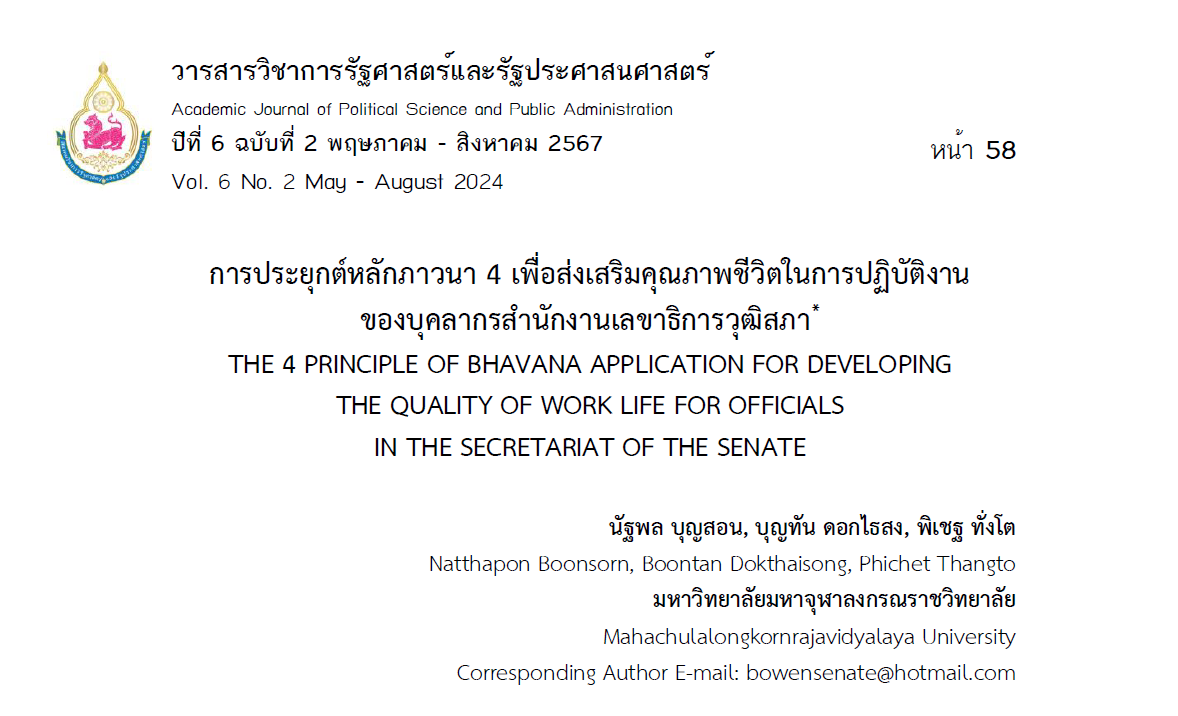การประยุกต์หลักภาวนา 4 เพื่อส่งเสริมคุณภาพชีวิตในการปฏิบัติงาน ของบุคลากรสำนักงานเลขาธิการวุฒิสภา
คำสำคัญ:
การประยุกต์, หลักภาวนา 4, คุณภาพชีวิตในการปฏิบัติงาน, สำนักงานเลขาธิการวุฒิสภาบทคัดย่อ
บทความวิจัยนี้มีวัตถุประสงค์เพื่อศึกษา 1. คุณภาพชีวิตในการปฏิบัติงาน 2. ปัจจัยที่ส่งผลต่อคุณภาพชีวิตในการปฏิบัติงาน และ 3. นำเสนอการประยุกต์หลักภาวนา 4 เพื่อส่งเสริมคุณภาพชีวิตในการปฏิบัติงานของบุคลากรสำนักงานเลขาธิการวุฒิสภา โดยใช้ระเบียบวิธีวิจัยแบบผสานวิธี การวิจัยเชิงปริมาณใช้แบบสอบถามที่มีค่าความเชื่อมั่นทั้งฉบับเท่ากับ 0.896 เก็บข้อมูลจากกลุ่มตัวอย่าง คือ บุคลากรสำนักงานเลขาธิการวุฒิสภา จำนวน 301 คน วิเคราะห์ข้อมูลโดยหาค่าความถี่ ค่าร้อยละ ค่าเฉลี่ย ส่วนเบี่ยงเบนมาตรฐาน การวิเคราะห์การถดถอยพหุคูณแบบมีขั้นตอน และการวิจัยเชิงคุณภาพใช้วิธีการสัมภาษณ์เชิงลึกกับผู้ให้ข้อมูลสำคัญ จำนวน 18 รูปหรือคน วิเคราะห์ข้อมูลโดยการวิเคราะห์เนื้อหาเชิงพรรณนาและการสนทนากลุ่มเฉพาะ จำนวน 9 รูปหรือคน เพื่อยืนยันองค์ความรู้หลังจากสังเคราะห์ข้อมูล
ผลการวิจัยพบว่า 1. คุณภาพชีวิตในการปฏิบัติงานของบุคลากรสำนักงานเลขาธิการวุฒิสภา ทั้ง 8 ด้าน ภาพรวมอยู่ในระดับมาก เมื่อพิจารณาเป็นรายด้านพบว่า ด้านที่มีค่าเฉลี่ยสูงสุด คือ ด้านลักษณะงานที่เป็นประโยชน์ต่อสังคม และด้านที่มีค่าเฉลี่ยน้อยที่สุด คือ ด้านค่าตอบแทนที่เพียงพอและยุติธรรม 2. ปัจจัยที่ส่งผลต่อคุณภาพชีวิตในการปฏิบัติงานของบุคลากรสำนักงานเลขาธิการวุฒิสภา พบว่า 1. ปัจจัยด้านการปฏิบัติงานส่งผลต่อคุณภาพชีวิตในการปฏิบัติงาน มี 4 ด้าน คือ นโยบายและการบริหาร ความสำเร็จในชีวิตการทำงาน การบังคับบัญชา และความสัมพันธ์ระหว่างบุคคล 2. หลักภาวนา 4 ส่งผลต่อคุณภาพชีวิตในการปฏิบัติงาน มี 2 ด้าน คือ กายภาวนา การพัฒนากาย และจิตภาวนา การพัฒนาจิต 3. การประยุกต์หลักภาวนา 4 เพื่อส่งเสริมคุณภาพชีวิตในการปฏิบัติงาน โดยการบูรณาการให้สอดคล้องกับปัจจัยด้านการปฏิบัติงานที่ส่งผลต่อคุณภาพชีวิตในการปฏิบัติงาน 4 ด้าน ได้แก่ นโยบายและการบริหาร ความสำเร็จในชีวิตการทำงาน การบังคับบัญชา ความสัมพันธ์ระหว่างบุคคล และหลักภาวนา 4 ที่ส่งผลต่อคุณภาพชีวิตในการปฏิบัติงาน 2 ด้าน คือ กายภาวนา การพัฒนากาย และจิตภาวนา การพัฒนาจิต
เอกสารอ้างอิง
กรมการพัฒนาชุมชน. (2551). รายงานคุณภาพชีวิตของคนไทยในชนบท ปี 2551. สืบค้น 28 มกราคม 2565, จากhttp://www.phichit.go.th/info_news/JorPorTor/JorPorTor_Thai.pdf
กรมสวัสดิการและคุ้มครองแรงงาน. (2562). คุณภาพชีวิตในการทำงาน (Quality of Work Life). สืบค้น 28 มกราคม 2565, จาก https://www.tosh.or.th/
index.php/blog/item/475-quality-of-working-life
กิตติชัย สุธาสิโนบล. (2553). การพัฒนารูปแบบการจัดการรียนการสอนแบบบูรณาการตามแนวพุทธ เพื่อสะท้อนแนวคิดปรัชญาเศรษฐกิจพอเพียงในบริบทแห่งสังคมไทย (ดุษฎีนิพนธ์ศึกษาศาสตรดุษฎีบัณฑิต สาขาวิชาหลักสูตรการสอน). กรุงเทพฯ: มหาวิทยาลัยเกษตรศาสตร์.
ไฉไลฤดี ยุวนะศิริ และคณะ. (2546). ผลสำเร็จในการปฏิบัติธรรมของพระนิสิตมหาวิทยาลัยมหาจุฬาลงกรณราชวิทยาลัยวิทยาเขตเชียงใหม่ (รายงานการวิจัย). พระนครศรีอยุธยา: มหาวิทยาลัยมหาจุฬาลงกรณราชวิทยาลัย.
พระครูวรธรรมวาที (นิพนธ์ ฉนฺทวุฑฺโฒ). (2565). การประยุกต์หลักพุทธธรรมเพื่อส่งเสริมประสิทธิภาพการปฏิบัติงานของบุคลากรที่ทำการปกครองในจังหวัดปทุมธานี (ดุษฎีนิพนธ์ปรัชญาดุษฎีบัณฑิต สาขาวิชารัฐประศาสนศาสตร์). พระนครศรีอยุธยา: มหาวิทยาลัยมหาจุฬาลงกรณราชวิทยาลัย.
ภูรีภัทร ห้วยหงส์ทอง. (2562). การบูรณาการหลักพุทธธรรมเพื่อส่งเสริมการพัฒนาคุณภาพชีวิตในการทำงานของบุคลากรกรมป้องกันและบรรเทาสาธารณภัย กระทรวงมหาดไทย (ดุษฎีนิพนธ์ปรัชญาดุษฎีบัณฑิต สาขาวิชารัฐประศาสนศาสตร์). พระนครศรีอยุธยา: มหาวิทยาลัยมหาจุฬาลงกรณราชวิทยาลัย.
สำนักงานเลขาธิการวุฒิสภา. (2565). แผนภูมิแสดงจำนวนบุคลากร. สืบค้น 2 ธันวาคม 2565, จาก https://service.senate.go.th/registration/satak1.php
สำนักงานเลขาธิการวุฒิสภา. (2566). แผนปฏิบัติราชการสำนักงานเลขาธิการวุฒิสภา พ.ศ. 2566–2570. กรุงเทพฯ: สำนักงานเลขาธิการวุฒิสภา.
Yamane, T. (1973). Statistics: an introductory analysis (3rd ed.). New York: Harper & Row.

ดาวน์โหลด
เผยแพร่แล้ว
รูปแบบการอ้างอิง
ฉบับ
ประเภทบทความ
หมวดหมู่
สัญญาอนุญาต
ลิขสิทธิ์ (c) 2024 วารสารวิชาการรัฐศาสตร์และรัฐประศาสนศาสตร์

อนุญาตภายใต้เงื่อนไข Creative Commons Attribution-NonCommercial-NoDerivatives 4.0 International License.




